Little Bird (1911-1944)
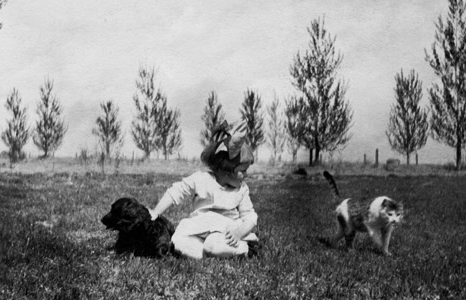
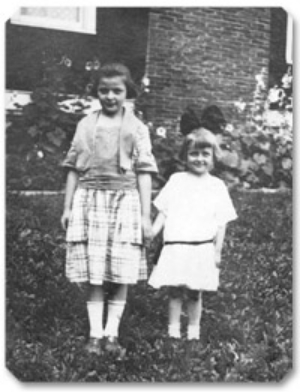
Carol Critchfield, Virginia’s sister, tells the story of how she and Virginia would play together on long summer afternoons in the big garage behind their Grandmother Higley’s home in Glen Ellyn, Illinois. Virginia invented many of their childhood games, including one of their favorites, “The Great Unknown,” in which Carol would wait breathlessly inside the garage until Virginia, outside, knocked slowly and dramatically upon the door. “Who is it?” Carol would whisper. “It is I,” came the mysterious and thrilling answer. “The Great Unknown.”
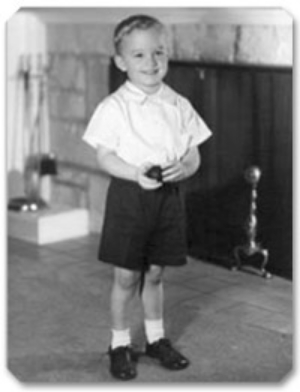
Paul Critchfield, Virginia’s nephew, fondly recalls his aunt during Christmas holidays, when she would pull up in her car with its Motorola radio to the front of his mother’s home in Riverside, Illinois, step out and walk over to unlatch the trunk, and then lift out an enormous laundry basket overflowing with gorgeously wrapped, sparkling Christmas gifts. To young Paul, the dazzling sight of his aunt bearing gifts-along with her own infectious spirit of joy and love-transformed Virginia into an almost magical figure of enchantment. He called her “Mrs. Claus.”
In the midwestern town of Glen Ellyn, Illinois, on an early winter day in 1911, the same year the French actress Sarah Bernhardt toured the United States, Marie Curie received her second Nobel Prize in chemistry, and thousands of women marched for women’s suffrage in New York and London,a first child was born to twenty-six-year-old Kenneth Neel Critchfield and twenty-four-year old Jessica Higley Critchfield. Virginia Critchfield was born on December 7 in the front parlor of her maternal grandparents’ home, a late Victorian residence on Duane Street. Present at Virginia’s birth were her grandfather, Dr. E. S. Higley, a physician; her grandmother, Cora V. Higley; and a nurse, Mrs. Helen Lennicke, who presented the newborn baby with the gift of a bonnet.
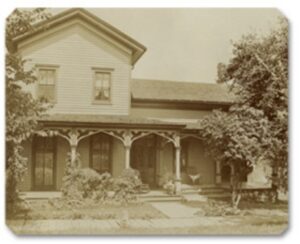
In a black-and-white photograph of the Higley parlor, a grand piano, brilliantly polished, sits in one corner of the room, sheet music arranged above the keyboard. Next to the imposing instrument rests a music stand upon which the pages of a score have been left invitingly open. Behind these, a full-length window covered with a plain sheer panel allows a measure of subdued light into the room. In another photograph of the room, a sawtooth fern droops on a delicate side table beside a stout armchair crowded with tasseled velvet cushions. A somber oriental pattern papers the walls of the high-ceilinged parlor, where photographs (presumably of family members) as well as several obscure landscapes hang at irregular intervals. The parlor gives the impression of a modestly appointed, unpretentious midwestern residence at the turn of the century, a middle-class home that reflects domestic order, civility, and an appreciation of the arts.
Virginia’s grandmother, Cora, was a Christian Science practitioner who also served as president of both the Glen Ellyn Women’s Club and the Glen Ellyn Library Association. On March 24, 1981, in a letter to Reverend Francis Moore, Virginia wrote the following:
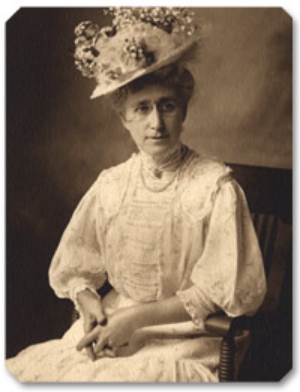
I, too, had a very special grandmother, a tiny, fragile lady with white “puffy” hair, an aristocratic black velvet ribbon around her neck, and seeming always to trail the gentle scent of jasmine. She was, despite her diminutive appearance, a strong, indomitable woman who made speeches, who drove an automobile long before other women, who championed human rights, and whose eyes twinkled as she wove fantastic stories for wide-eyed children or stirred up delectable pots of fudge. How fortunate we are to have had these wonderful people in our lives and how precious are the memories in which they figured so prominently, so meaningfully.
The seeming contradiction between a diminutive lady with twinkling eyes who trailed “the gentle scent of jasmine” and a woman who championed the rights of others, traveled alone, made speeches, and generally challenged behaviors judged appropriate for women at the close of the Victorian era, reflected conflicting social expectations and cultural tensions of American women between 1890 and 1920. Virginia was born in the middle of this change. As the nation emerged into a more modern, urban, industrial, and bureaucratic era, women of the upper, middle, and working classes,in uneasy alliance,advocated for voting rights and political reforms, broader educational opportunities, and safer, unionized work environments.
Modern advances reduced domestic labor, opening new opportunities for leisure and pleasurable consumption, for increased education, and for the formation of collective alliances, such as settlement houses, labor unions, and women’s clubs, and larger political alliances, such as the National American Woman Suffrage Association. Women in newly significant numbers were going outside their homes to engage in civic-minded activities, social reforms, and political rallies, breaking down Victorian notions of gender segregation and beliefs about the limits of women’s intellect and abilities. With the collective power of independent, middle-class women such as Cora Higley and like-minded women from other socioeconomic groups, the social and political parameters of American women’s lives expanded. By her strong example of civic leadership and spiritual ministry, Cora Higley demonstrated the ability to embody leadership in the presence of seemingly contradictory interests and actions to the granddaughter she affectionately nicknamed “Little Bird.”
In contrast is young Jessica Higley, Virginia’s mother, whom we can observe in a sepia photograph, her head wrapped loosely with a long, knotted bohemian scarf. Wearing rings and bracelets on her fingers and wrists, Jessica, perhaps twenty, stares into the camera with an insouciant artistic flair. Jessica, a trained pianist, taught music and enjoyed a brief career as an accompanist to the silent movies, memorizing over five hundred songs and providing a musical education to her daughters and entertainment to friends. Growing up with the differing examples of temperaments and roles that her grandmother and mother provided, Virginia would inherit and develop her own traits of civic leadership, spiritual conviction, humanitarian engagement, and artistic sensitivity.
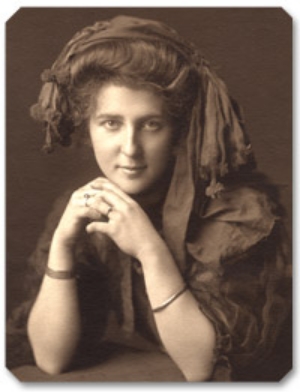
On April 20, 1912, four-month-old Virginia, Little Bird, accompanied her mother on the two-and-a-half-day train ride from downtown Chicago to Wendell, Idaho, where they joined Virginia’s father, a civil engineer who had found work building bridges along the Snake River.
Wendell, just north of Twin Falls, was a raw western settlement consisting of one dirt road, Main Street, with rough-hewn wooden sidewalks, wooden clapboard buildings, and a single hotel, the Lincoln Inn, where little Virginia sometimes dined with her parents. Over the next four years, they lived outside of Wendell on a small property called “The Ranch,” in a plain one-story home with a screened front porch. Beyond the barn, windmill, chicken coop, and small water tower stretched the featureless, isolated expanse of open prairie, a scoured flatness of horizon relieved only by sagebrush and a sparse copse of trees.
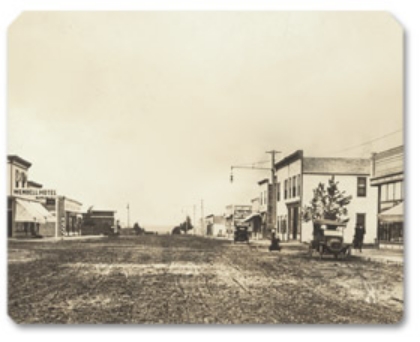
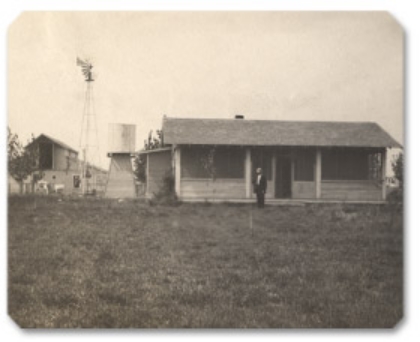
Black-and-white photographs from that era show Little Bird at the age of two in loose overalls and a sun hat, standing with sturdy-legged confidence against a monotonous backdrop of prairie, maternally nestling a kitten or a puppy, sometimes both, in her arms.
At three or four years of age, Virginia poses again outside the Critchfield ranch house, triumphantly, if awkwardly, clutching a half-wilted bouquet of wildflowers. She wears a drop-waisted white dress, white heavy stockings with wrinkles etched in the knees, and leather button-strap shoes; a great white bow is pinned to one side of her head, and her straight brown hair is styled in a bob.
These early images of Virginia at the ranch suggest a propensity, from her tenderest years, to appreciate the unadorned honesty of her surroundings, to prize the companionship of animals, to adapt to solitude, and to find security in the love of her parents, two people to whom she would remain deeply attached all her life. In later years, Virginia often attributed her innate shyness to those early, formative years in Wendell, where she spent so much of her time alone.
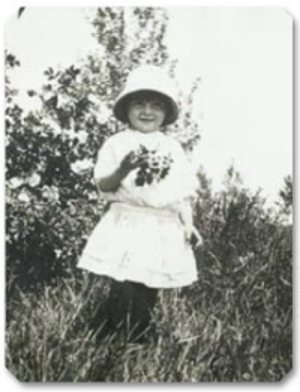
As Ken Critchfield engineered bridges along the Snake River in remote southern Idaho, Jessica rode to outlying ranches, on horseback, to give music lessons. Jessica, later known to friends and family as “Dearie”, often accompanied her husband, who played the violin. Her parents’ daily concerts would be a cherished, fondly recalled part of Virginia’s upbringing.
With her father away building bridges and her mother riding horseback from ranch to ranch teaching music, Little Bird doted on her various ranch pets: ducks, chickens, dogs, cats, horses, and cows. According to Jessica, Virginia’s favorites were the dogs and the cows, each one bestowed with its own nickname. On March 1, 1913, Virginia’s father surprised her with a little white puppy she named Banjo, and on May 1, he brought her a second dog, an Airedale she named Bonnie. Upon seeing her first coyote at the ranch in November 1913, Virginia cried out, “Oh, pretty doggy!”
Jessica lovingly recorded her daughter’s precocious sayings in a baby book, noting that Virginia’s very first expression, often repeated, was “Well, well, well.” Virginia’s mother also noted, “She is rather slangy for a girl. She says, “Doggone it” and “What do you know about that?” and “Beat it.” She says, “Bless your old heart,” to her dog, Banjo.” And when Jessica was lying down one day with a headache, little Virginia came up to her and asked, “What’s the matter, hon? Does it hurt all over?” On September 21, 1912, Jessica noted with amusement how Virginia reacted to her first money: “A Lincoln penny was given to her by Fred Clark. She seemed pleased and immediately tried to put it in her mouth.” The family’s second Christmas, celebrated in Wendell, was marked by a sagebrush Christmas tree and small gifts mailed by relatives and brought over by nearby neighbors.
Virginia’s early years included an unusual number of extended journeys. On July 29, 1913, she and her mother left Wendell for Glen Ellyn, where she visited her Higley grandparents until October 20. When Ken was able to join them for three and a half weeks in August, Virginia enjoyed her first automobile ride in Grandfather Higley’s new touring car, a Keeton. Owning an automobile in those days was not only a novelty and even a luxury, but also a modern adventure that Cora Higley, true to her independent, outgoing spirit, shared in by learning to drive.
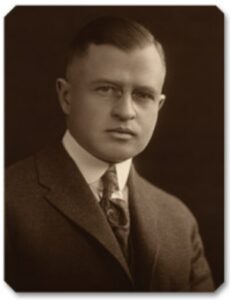
Neel Critchfield
Back in Wendell for her third Christmas in 1913, Virginia was delighted by the large, lovely Christmas tree in her home, decorated with trimmings sent by Grandfather Higley. Virginia adored the holiday tree and, as Jessica noted, kept circling around it, exclaiming, “Well-sake!”
Then, on September 2, 1914, Virginia, not quite three years old, took a train ride with her mother, arriving in Chicago on September 5, where they spent two days shopping. Virginia was treated to her first elevator ride and a luncheon at Mandel’s Tea Room. While in Glen Ellyn visiting her maternal grandparents again, Virginia, her mother, and Grandmother Higley took the train to Ohio on September 18. After arriving in Langsville, they visited Cora Higley’s childhood home, a large farmhouse, and met innumerable great aunts, great uncles, cousins, and even eighty-two-year-old Great-grandfather Higley at the original Higley homestead, a farmhouse and barn nearly a hundred years old. While in Langsville, Virginia also attended her first Sunday school service at Wesley Chapel, the same small church where her Grandmother Cora, Great-grandmother Van Zandt, and Great-great- grandmother Eakin had each attended their first Sunday school services. Virginia, Jessica, and Cora, three generations of Higley women, returned to Glen Ellyn on October 7.
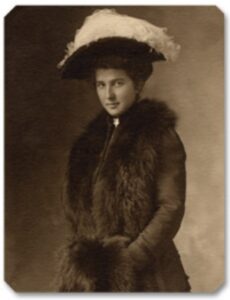
Additional excursions for Virginia included a trip to Lincoln Park in Chicago during August 1917 and a trip that same month to Madison, Wisconsin, to see her father, who was temporarily employed there. The number and variety of Virginia’s childhood travels with her mother and grandmother point again to the untrammeled spirit of these women, an intrepid zest for adventure tempered by a respect for family and tradition that Virginia would exemplify in her own adult life.
Virginia’s sister, Carol Ann Critchfield, was born on November 28, 1915, marking the beginning of a lifelong, deeply affectionate sibling companionship. Less than two years later, in September 1917, when Virginia was five years old, she began attending Duane Street School in Glen Ellyn, entering the same building and sitting in the identical classroom as her mother had at that same age. During Virginia and Carol’s formative years, spanning two world wars and the Great Depression, economic constraints called for a spirit of playful innovation and creative invention. From a young age, Virginia possessed an ingenious capacity for inventing dramatic games and theatrical stories, while Carol,already a budding artist, used the cut-open, blank insides of cereal boxes to practice her drawings. With very little in the way of material goods or toys, the girls made up marvelous games and activities. The emotional stability offered by their loving parents and grandparents, frequent visits with extended family members, and traditionally observed celebrations of holidays and birthdays also provided Virginia and Carol with ample emotional comfort and security to buffer them from harsher economic realities.
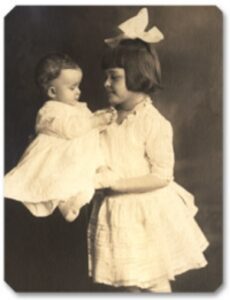
When the family later moved from Glen Ellyn to St. Louis, Missouri, to a house at 4014 Connecticut Street, Virginia, then eleven or twelve years old, attended a new school. A collection of letters from Cora Higley to her granddaughter between 1923 and 1929, Virginia’s adolescent years, addresses among other subjects Virginia’s apparent recalcitrance about school and her lessons. This fragile packet of handwritten letters, saved by Virginia for over seventy years, reveals her grandmother’s affectionate mentorship, which firmly outlined the Christian Science teachings and lessons Cora felt were important for her adolescent granddaughter.
To Virginia, My Darling Virginia,
Was so glad to get your letter, very sorry about the English. I will do my best. I think first of all, declare there is just one teacher and see “God.” As long as you resent or feel angry with your teacher, you will not be able to lose the emotions. Read Science and Health, page 45, line 19.
Remember God’s idea, in its perfect expression, is in your consciousness, and all you have to do is to acknowledge it. Also page 17. “Give us grace for today; feed the famished affections.” This is made your own. Keep it in mind until the spiritual sense comes to you. That Truth will free you from the thoughts of yourself or anybody as person. English is only a word. So it is God’s idea in your consciousness and is unfolding according to God.
For Virginia, My Dear Virginia,
I will work for you and you know how glad Gramma always is when you turn to Christian Science and ask me to help you.
Now dear, keep declaring love. "God is all and God is Love." Mentally see the word Love, and then your mind will be more receptive to the Truth I declare. The ninety-first Psalm is splendid, and if you will commit it to memory, it will help you very much. Read some in Science and Health every day, beginning at the first of the book. Subject on Prayer. You see a treatment is prayer, and so reading that is the same as a treatment. Write to me every few days, especially if anything new comes up. But don't be afraid.
Virginia, keep declaring quite often, "I reflect intelligence." Don't think of yourself, but see the word "intelligence." Keep your mind filled with Truth and Love, and you will be well soon. I must close now and go upstairs to work. It would certainly be grand if you could go to a Christian Science church. I will look for the photoplay tomorrow and send it. Am looking forward to Christmas.
Virginia would honor her grandmother’s words throughout her life, frequently quoting Christian Science sayings and prayers. Neatly inscribed in her baby book is the first Christian Science prayer Virginia memorized:
Now I lay me down to sleep;
I know that God his child does keep.
God is my all; I know no fear,
since God and Love and Truth are near.
I know that God my life is nigh.
I live in Him; I cannot die.
God is my health; I can't be sick.
God is my strength, unfailing, quick.
Cora Higley’s letters, teachings, and prayer treatments made an indelible impression on both granddaughters, and, grandmother’s positive influence. The numerous letters from Cora to Virginia underscore the unique spiritual tenor of their relationship.
As a practitioner, a kind of pastor or lay minister, Cora performed “treatments” upon members of her family, assisting with the various challenges and troubles in their lives through prayer. Much like the Quaker faith, Christian Science offered a rare public space and an opportunity for women, in this case as practitioners, to effect spiritual leadership both in their families and within the broader Christian community.
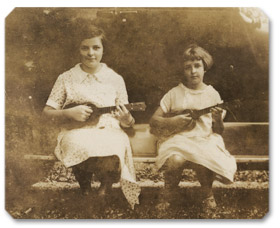
Two fond recollections Carol has of the family’s years in St. Louis involve music and the movies. Gathering around the piano after supper was a nightly tradition in the Critchfield home. Carol learned to play the violin and Virginia the organ, the latter remaining in Virginia’s home years after it had become more of a nostalgic presence than a played instrument.
During an era of national economic crisis, the Critchfields provided their daughters with a priceless delight in music that would carry into their adult lives. Ken and Jessica also managed, despite straitened circumstances, to take young Virginia and Carol to the movies every Saturday night, treating them afterward to butterscotch sundaes, a memory both sisters treasured. The notion that entertainment can be self-generated, that the pleasures of artistic expression can be self-taught, practiced, and shared with others, is an invaluable lesson, and because of their parents’ generosity and ingenuity, the Critchfield sisters absorbed it well.
In 1930, the family left St. Louis and returned to Illinois, initially settling at 201 North Cuyler Avenue in Oak Park and later at 851 North Euclid Street. According to the Fifteenth Census of the United States, April 1930, Ken Critchfield (age forty-five), who was employed as a stationary engineer at an ice plant, Jessica (forty-two), Virginia (eighteen), Carol (fourteen), and Cora Higley (sixty-nine), a widow at that time, all lived together in Oak Park Village. The series of family moves suggests Ken Critchfield’s need to follow employment opportunities. In at least one instance, he was separated from his family, working elsewhere to provide a secure environment for Virginia and Carol,while his wife, daughters, and mother-in-law stayed in one place. Years later in 1964, Virginia, who was fifty-three at the time, paid the following spontaneous tribute to her parents in an audio “living letter” recorded at her home on Normandy Place in Evanston, Illinois:
Hi Ken and Dearie,
This is Gin, recording to you from my own control tower up here on the second floor overlooking the garden. It's Thursday, February 6, and the time is just 12:30 in the afternoon. I've just received your tape and had the joy of playing it, and I couldn't help thinking again how warm and touching and beautifully worded your little, shall I say, your tribute, was to all of us, Daddy, when you relayed it again in a nostalgic way, the happy Christmases we had when we were a family living together in Oak Park. Indeed, those are times we'll cherish to the end of our days, and though Carol and I probably have never expressed our gratitude adequately, I'm sure you know, and if not, I want you to know it now, from me and from the bottom of my heart, how much Carol and I appreciated all that you two did for us to keep our family together when the times were not always so easy.
Particularly, Carol and I now, as adults ourselves, can appreciate and understand the sacrifice you made for us when you lived apart so long just so we could keep our home in Oak Park, and we girls could continue in school and remain with our friends in an atmosphere that had been home for us. In other words, Daddy, rather than disrupt the whole family and pull up the roots again and move us off to New York or New Jersey or wherever it was that you had to be exiled for over a year, you let us remain in Oak Park, in that beautiful home, which we did love so much, and you and Mother really made a supreme sacrifice to spend all of that time separated. And as I say, now I appreciate completely what that meant. And I hope I can convey that to you both now.
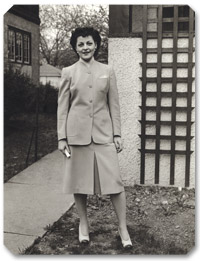
The Great Depression,which began with the stock market crash of October 29, 1929, and would not abate until the nation at war required full employment, had devastating nationwide effects, worst among them crippling poverty, rampant unemployment, home and farm foreclosures, and prolonged hunger and homelessness. As the economic depression took hold and deepened, Virginia, a young woman of eighteen when the stock market crashed, may have had little choice other than to seek employment and remain at home with her parents once she graduated from Oak Park High School.
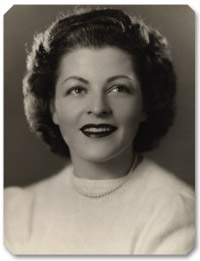
Virginia secured a job as a receptionist and office manager for an ear, nose, and throat specialist, Dr. Jerry Greenwood, in downtown Chicago. Carol pursued a career in commercial art and fashion illustration, taking classes and studying at the Art Institute of Chicago. The Depression, a national emergency of epic proportion, scarred an entire generation and damaged all aspects of American life. As young women just then beginning to define their adult lives, Virginia and Carol found themselves working hard within a frightening national context of near economic collapse. Bread lines, soup kitchens, and public works projects served as temporary steps to help ward off hunger and despair. To be securely employed, as both Virginia and Carol were, was an achievement. They were fortunate, too, in continuing to have an exceptionally close and loving relationship with one another and with their parents.
As a firstborn child spending her earliest years on a remote ranch, Virginia had had to learn self-reliance. With the onset of the Depression, eighteen-year-old Virginia learned that food on the table and a roof to live beneath necessarily superseded loftier dreams and ambitions. Many years later, Virginia’s friends would attest to her great love of romance in books, movies, songs, and theater. A romantic temperament would have been difficult to sustain during the decade-long Depression, with economic deprivations that did not ease until Virginia was in her early thirties. For an entire generation of young Americans, to work and be paid for one’s work would have to be enough. Loftier goals-even conventional dreams of marriage, a home, and children,were often deferred. Even so, it is tempting to imagine that as her twenties advanced, Virginia might have thought life was passing her by; certainly any private dreams she may have had must have seemed as if they were receding.
Photographs of Virginia around this time portray a young woman with stylishly thinned eyebrows and a bobbed hairstyle, in moderate keeping with the flirtatious, independent “flapper” spirit of the day,an attractive yet pensive woman, smiling a bit ironically as if aware of the gap between the near-glamorous image of a modern young woman and the reality of life as an unmarried medical receptionist in her early thirties still living at home.
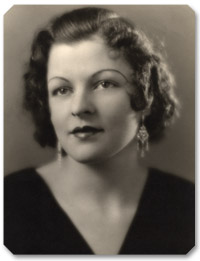
With the advent of the Great Depression, the flapper image would be replaced by another iconic image: the resourceful, sophisticated maturity of a Katharine Hepburn, a Bette Davis, a Marlene Dietrich, or a Greta Garbo. The economic disaster of 1929 allowed no one the illusion of the exuberant ‘20s, and Virginia’s life, like the lives of her contemporaries, reflected that diminution of gay spirits and independent pleasures. Work had become terrifyingly scarce and the competition for it brutal. Privacy, too, had become a lost luxury as families crowded together and young people like Virginia delayed marriage, muting their natural inclinations toward romance and matrimony because of rampant financial instability. Whole populations of urban single women struggled to survive, but as the ‘30s merged into the ‘40s and the Depression began to recede, everything would change with the Japanese attack on Pearl Harbor. World War II began for Americans on December 7, 1941, Virginia’s thirtieth birthday, and suddenly the patriotic fervor of wartime, coupled with an urgent need for women in the workforce, ushered in yet another era.
Years later, Virginia would openly claim that her real life began when she met Paul Galvin. As America entered the Second World War, she could scarcely have anticipated or prepared for the great stroke of destiny in 1944 that would lift her out of all that she had known or experienced and plunge her headlong into what she would call “her storybook life.”



